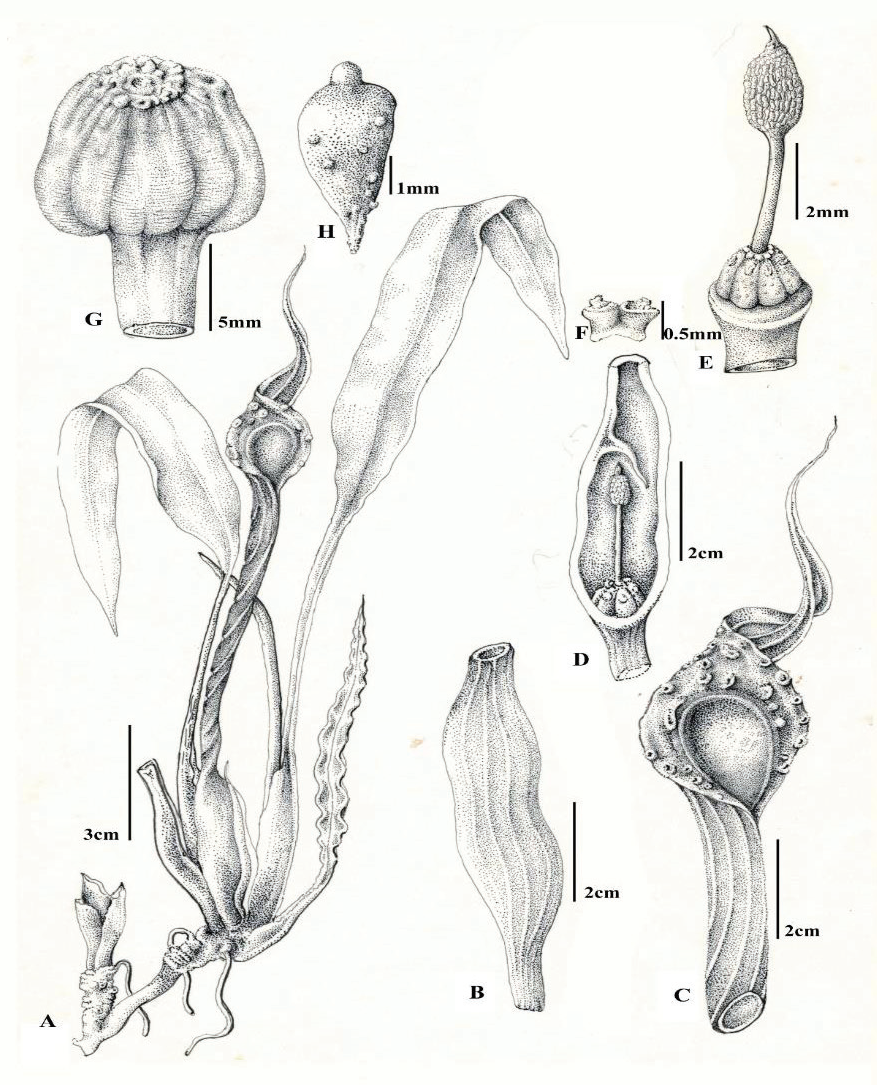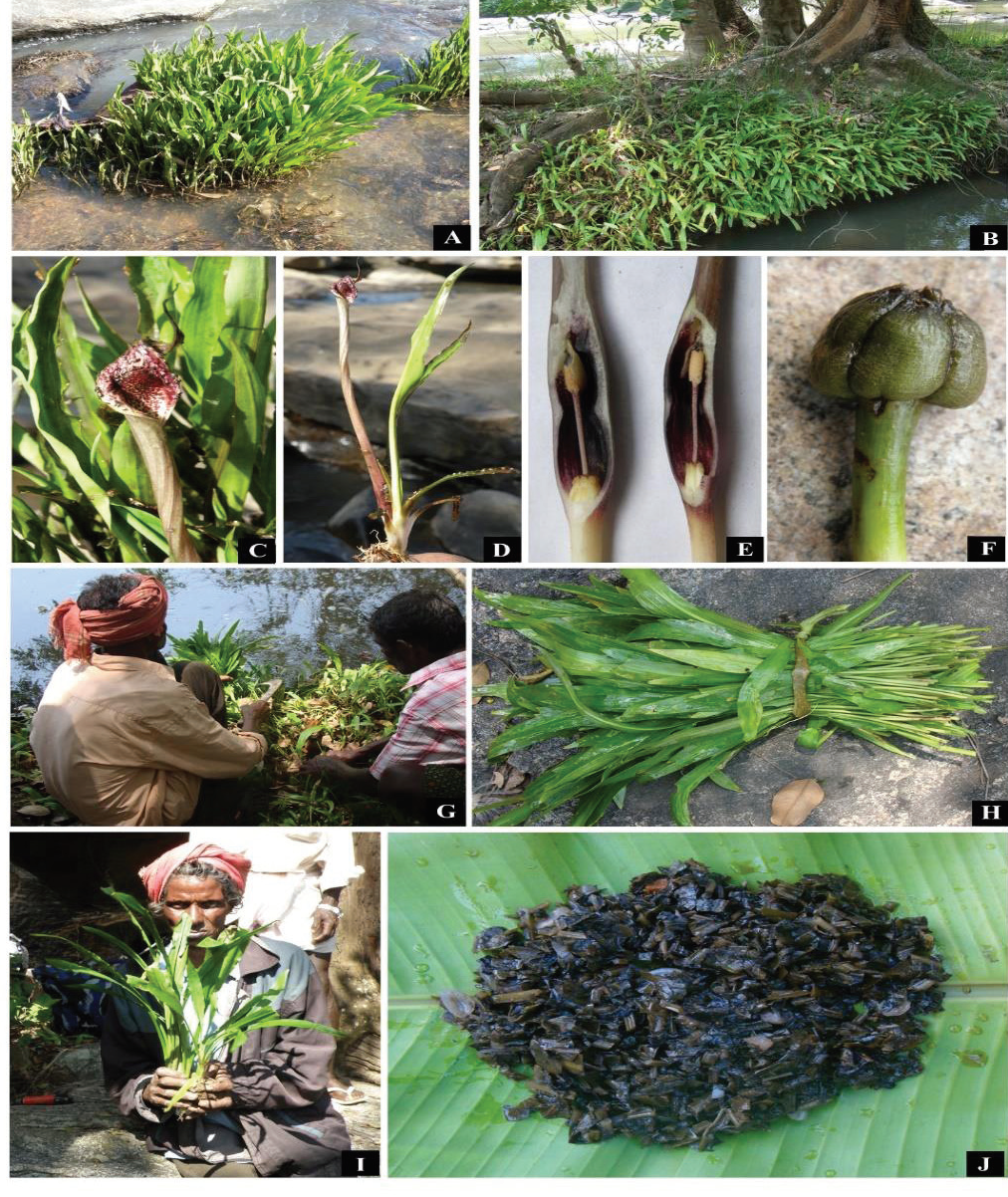Review Article
Occurrence and Ethnic Uses of Cryptocoryne consobrina Schott, A Lesser-Known Endemic Aroid, in Kerala and Tamil Nadu
Shaju T1, Shaji PK2, Ajinsha JS3, Ratheesh Narayanan MK4* and Sunil CN5
1,3Jawaharlal Nehru, Tropical Botanic Garden and Research Institute, Palode, Karimankode P.O., Thiruvananthapuram – 695562, Kerala, India
2Environmental Resource Research Centre, Peroorkada P.O, Thiruvananthapuram – 695 005, Kerala, India
4Department of Botany, Payyanur College, Edat P.O., Kannur – 670 327, Kerala, India
5Department of Botany, S. N. M. College, Maliankara P.O, Ernakulam – 683 516, Kerala, India
4Department of Botany, Payyanur College, Edat P.O., Kannur – 670 327, Kerala, India
5Department of Botany, S. N. M. College, Maliankara P.O, Ernakulam – 683 516, Kerala, India
*Corresponding author: Ratheesh Narayanan MK, HOD and Assistant Professor Department of Botany Payyanur College, Kannur, Kerala India. E-mail Id: drratheeshpoduval73@gmail.com
Copyright: © Shaju T, et al. 2023. This is an open-access article distributed under the Creative Commons Attribution License, which permits unrestricted use, distribution, and reproduction in any medium, provided the original work is properly cited.
Article Information: Submission: 20/04/2023; Accepted: 19/07/2023; Published: 22/07/2023
Abstract
Cryptocoryne consobrina Schott, a narrow endemic and threatened plant species of the Western Ghats, is described. Notes on distribution, ethnobotanical uses along with photographs and illustrations are also provided. The present collection of this species, from Idukki District and Tiruppur District, confirming its occurrence in Kerala and Tamil Nadu respectively. The plant grows in thickets along the riverbank and exposed areas of the riverbed. The plant forms a preferred leafy vegetable for the local inhabitants, especially the Malappulaya Tribe of Marayur apart from being a herbal remedy for peptic ulcer.
Keywords: Araceae; Cryptocoryne; Endemic, Kerala; Malappulaya Tribe; Tamil Nadu
Introduction
The genus Cryptocoryne of family Araceae is represented by about
50 species in the tropics embracing Asia and Malaysian Archepelago
(Mayo et al., 1997) [1], including six species reported from the
Indian subcontinent (Sunil and Sivadasan, 2009) [2]. Cryptocoryne
consobrina was originally recognised and named by Schott in 1857
based on a collection from ‘Nilgherries’ (Nilgiris), India in Hooker
and Thomson’s herbarium (K). Branes collected the species from
Parambikulam and adjacent Karappara river basin of Kerala in 1934,
after which no collection was known from Kerala. Though a specimen
of Cryptocoryne collected from Malappuram District in Kerala was
misidentified as C. consobrina (Sivadasan, 1985; Jacobsen et al.,
1989a, 1989b) [3,4,5], it turned out to be a new species C. sivadasanii
on detailed investigation by Bogner (2004) [6]. Sabastian collected the
species from Aliyar submergible area of Coimbatore District, Tamil
Nadu in 1962, after which no collection was known from Tamil Nadu.
The species, which was considered extinct until recently has been
rediscovered by Sunil and Sivadasan (2009) [2] from Coorg District
in Karnataka State. The present collection of Cryptocoryne consobrina
Schott, from Marayur in Idukki District and Kodanthoorkkudi in
Tiruppur District, while confirming its occurrence in Kerala and
Tamil Nadu respectively forms distributional record from new
localities of the two southern States of India.
The location of the collection in Kerala (10o 15’ 12.5” N latitude
and 77o 10’ 21.6” E longitude) at an altitude of ~865 m above MSL
is within Pambar River basin, one of the three east-flowing rivers of
the Kerala, which is a tributary of Amravathi River in Tamil Nadu
that eventually joins River Kaveri near Karur. The site of collection in
Tamil Nadu (10o 15’ 12.5” N latitude and 77o 10’ 21.6” E longitude)
at an altitude of 423 m above MSL is within Amaravathi River basin,
downstream of the former. The plant grows in thickets along the
riverbank and exposed areas of the riverbed, which is characterised
by rocky (polygonal) boulders with several potholes at places. A thin
layer of soil along with debris trapped between boulders make an
excellent habitat for its profuse growth. Incidentally, the plant forms
a preferred leafy vegetable for the local inhabitants, especially the
Malappulaya Tribe of Marayur apart from being a herbal remedy for
peptic ulcer.
The following forms a brief taxonomic description of the specimen
collected, along with illustrations and photographs covering its
habitat, habit, characteristic features and ethnic uses.
Cryptocoryne consobrina Schott, in Bonplandia 5: 222. 1857,
Prodr. Syst. Aroid. 16. 1860; Engler in DC., Monogr. Phan. 2: 626.
1879; Hook..f., Brit. India 6: 493. 1893; Engler, Pflanzenr. IV. 23F (73):
247. 1920; Fischer in Gamble, Fl. Pres. Madras 1575.1931, in Hooker’s
Icon. Pl. 34: t. 3305, 1939; de Wit, Misc. Pap. Landbouwghoge school
6: 265. 1970, Aquarienpfl. 142. 1971; Rataj, Stud, CSAV 3: 42. 1975;
Jacobsen, Cryptocoryner 54. 1979; Cook, Aqua. Wet. Pl. India 55.
1996; Sunil & Sivadasan, Aroideana 32: 142- 146. 2009.
Type: Maisor and Carnatic, ‘Nilgherries’, Herb. Ind. Or. Hook. f.
& Thomson, Madras Coll. No. 34 (K000950319!).
Submerged to emergent rhizomatous creeping perennials.
Rhizome 0.5-1.5 cm thick knotty, white inside. Leaves dimorphic,
petiolate: submerged leaf blades 2-6 x 0.5-1 cm, linear- lanceolate,
base cuneate, margins closely undulate, apex acuminate, dark green
coloured, petiole 2-6 cm long; emergent leaf blades, 5-45 x 1-6 cm,
flat, linear-lanceolate to lanceolate, base cuneate running in to the
3-20 cm long petiole, margins entire, apex acuminate, light green
coloured. Spathes 6-20 cm long. peduncle 1.5-6 cm long; spathe
with basal swollen cylindrical tube (kettle), light purple without
and deep purple within; transverse septum roofing the cylindrical
portion creamy in colour with many purple spots; upper tube up
to 11 cm long, light purple, slightly twisted, with a collar around
the mouth and purplish spots at the throat within and down below;
apical limb portion expanded, 2.7-6 x 0.7-1.4 cm, ovate-lanceolate,
long acuminate, sometimes refluxed and twisted; greenish brown
outside, creamy to yellowish within with deep purple or reddish
spots, verrucose, margins with warty teeth-like projections. Spadix
enclosed in the cylindrical swollen base of spathe, 1-2 cm long with
conical pistillate portion at the base followed by a sterile naked
portion; staminate portion ellipsoid with a terminal sterile top-shaped
appendix. Female flowers 5-6 at base, connate in a whorl, 1-locular;
stigma sessile, circular with central depression; ovules many; a few
neuter flowers present at the top of the pistillate portion, Male flowers
many, each with a single bithecal sessile stamen. Infructescence 9-15
mm across, ovoid to conical; seeds numerous, ellipsoid.
Flowering & Fruiting: December- February
Habitat: Riverine
Distribution: Endemic to the southern Western Ghats
(Karnataka, Kerala and Tamil Nadu)
Specimen examined: Karnataka State, Coorg District, Cauvery
Nissargadana, ca. 1000 m MSL., 27-01-2006, C.N. Sunil 4101 (CALI);
Ibid., 03–0302007, C.N. Sunil 4237 (CALI); Kerala State, Idukki
District, Pambar, ca 865 m, 7–11–2010, T. Shaju & P.K. Shaji, 7561
(ERRC); Tamil Nadu, Tiruppur District, Kodanthoorkkudi, 423
m, 28–12–2011, P.K.Shaji & T. Shaju, 74200 (TBGT); Kerala State,
Idukki District, Pambar, near Thoovanam falls, 865 m., 09–06–2022,
J. S. Ajinsha, 99515 (TBGT).
Ethnic uses by the Malappulaya Tribe: Cryptocoryne consobrina
is used as a leafy vegetable (the preparation is said to be medicinal as
well), especially by the Malappulaya Tribe of the Chinnar-Marayur
belt. The Tribe, also known as ‘Karavazhis’, represents one of the
primitive agrarian ethnic groups confined to the Anchanad valley
in Idukki District. They collect the leaves either by cutting them
individually or by uprooting the whole plant and gathering the
leaves separately. The freshly harvested leaves are washed and cut
into small pieces of 1–2 cm. The chopped leaves are then boiled in
salted water for 2-3 minutes in an earthen pot, the water is drained
off thereafter, and the process is repeated 3-4 times. The half-cooked
leaves are then crushed using a wooden ladle (thavi) and made into
an aggregate mass by adding grated coconut, chopped onions green
chillies, turmeric powder and salt. In a separate earthen vessel (chatti)
or kadai, oil (coconut oil) is heated and mustard seeds spluttered
followed by adding curry leaves and 2-3 red chilies. To this, the above
leaf mass is added, sprinkled with little water and covered the vessel
using a lid (another flattened earthen vessel, adappu chatti). After
simmering for about 5 minutes, the lid is removed and the whole
content is mixed thoroughly and kept it on low flame till done. The
preparation (thoran) is served hot as a side dish with boiled rice in
plantain leaves [Figure 1,2].
The plant is also used as a herbal remedy for peptic ulcer by the
same Tribe living across the State border, at Kodanthoorkkudi in
Tamil Nadu, in the vicinity of Amaravathi Reservoir. Here, the freshly
harvested whole plant is washed and chopped into pieces followed by
boiling in water for 2-3 minutes. After the water is drained off, a paste
of turmeric (fresh fingers), garlic (cloves) and asafoetida is added to
the whole aggregate and is cooked in low flame until a dry mass is
obtained which is consumed orally twice a day by the patient for a
period of 7-10 days.
Conclusion
Cryptocoryne consobrina Schott, was believed to be an extinct
species until it has been rediscovered from Coorg District of Karnataka
State in 2009. The present collections confirming its occurrence in
Kerala and Tamil Nadu forms distributional record respectively for
the two southern States of India. The species sparsely distributed
in the localities of collection owing to destruction/alteration of
habitat and assessed as ‘Near Threatened’, as there is a continuing
decline in the quality of habitat as well as extent of occurrence. For
conserving the species, no management actions known to be taken.
It is therefore, imperative to assess the extent of occurrence and
pattern of distribution of the species, towards planning conservation
Figure 1: A & B. Habitat, C & D. Plants with inflorescence, E. Kettle of spathe cut-opened showing spadix F. Infructescence, G. Tribes harvesting the leaves, H.Bundle of freshly harvested leaves, I. Malappulaya Tribe holding uprooted plants, J. Leaf based delicacy of Malappulaya Tribe.
Figure 2: A. Habit, B & C. Inflorescence (b. Basal portion of spathe with swollen cylindrical tube (kettle), c. apical portion of spathe showing limb) D. kettle of spathe cut-opened showing spadix, E. Spadix with pistillate &staminate portions F. Male flower, G. Infructescence, H. seed
management. Cryptocoryne consobrina Schott, is also used as a leafy
vegetable and herbal medicine by the agrarian ethnic groups of the
locality.


